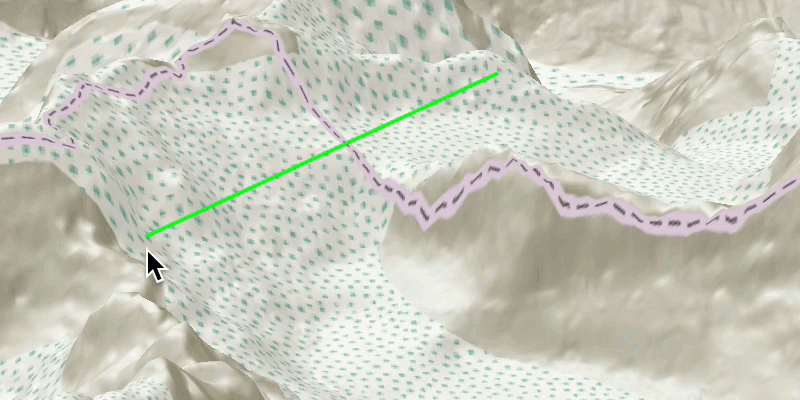Perform a line of sight analysis between two points in real time.

Use case
A line of sight analysis can be used to assess whether a view is obstructed between an observer and a target. Obstructing features could either be natural, like topography, or man-made, like buildings. Consider an events planning company wanting to commemorate a national event by lighting sequential beacons across hill summits or roof tops. To guarantee a successful event, ensuring an unobstructed line of sight between neighboring beacons would allow each beacon to be activated as intended.
How to use the sample
The sample loads with a preset observer and target location, linked by a colored line. A red segment on the line means the view between observer and target is obstructed, whereas green means the view is unobstructed.
Click to turn on the mouse move event listener, then move the mouse to update the target location in real time. Click again to lock the target location.
How it works
- Create an
AnalysisOverlayand add it to the scene view. - Create a
LocationLineOfSightwith initial observer and target locations and add it to the analysis overlay. - Make an
EventHandler<MouseEvent>to capture mouse movement. Turn the screen point into a scene point withsceneView.screenToLocationAsync(screenPoint). - Update the target location with
lineOfSight.setTargetLocation(scenePoint).
Relevant API
- AnalysisOverlay
- LocationLineOfSight
- SceneView
Tags
3D, line of sight, visibility, visibility analysis
Sample Code
/*
* Copyright 2017 Esri.
*
* Licensed under the Apache License, Version 2.0 (the "License"); you may not
* use this file except in compliance with the License. You may obtain a copy of
* the License at
*
* http://www.apache.org/licenses/LICENSE-2.0
*
* Unless required by applicable law or agreed to in writing, software
* distributed under the License is distributed on an "AS IS" BASIS, WITHOUT
* WARRANTIES OR CONDITIONS OF ANY KIND, either express or implied. See the
* License for the specific language governing permissions and limitations under
* the License.
*/
package com.esri.samples.line_of_sight_location;
import java.util.concurrent.ExecutionException;
import javafx.application.Application;
import javafx.event.EventHandler;
import javafx.geometry.Point2D;
import javafx.scene.Scene;
import javafx.scene.input.MouseButton;
import javafx.scene.input.MouseEvent;
import javafx.scene.layout.StackPane;
import javafx.stage.Stage;
import com.esri.arcgisruntime.ArcGISRuntimeEnvironment;
import com.esri.arcgisruntime.concurrent.ListenableFuture;
import com.esri.arcgisruntime.geoanalysis.LocationLineOfSight;
import com.esri.arcgisruntime.geometry.Point;
import com.esri.arcgisruntime.geometry.SpatialReferences;
import com.esri.arcgisruntime.mapping.ArcGISScene;
import com.esri.arcgisruntime.mapping.ArcGISTiledElevationSource;
import com.esri.arcgisruntime.mapping.BasemapStyle;
import com.esri.arcgisruntime.mapping.Surface;
import com.esri.arcgisruntime.mapping.view.AnalysisOverlay;
import com.esri.arcgisruntime.mapping.view.Camera;
import com.esri.arcgisruntime.mapping.view.SceneView;
public class LineOfSightLocationSample extends Application {
private SceneView sceneView;
@Override
public void start(Stage stage) {
try {
// create stack pane and JavaFX app scene
StackPane stackPane = new StackPane();
Scene fxScene = new Scene(stackPane);
// set title, size, and add JavaFX scene to stage
stage.setTitle("Line of Sight Location Sample");
stage.setWidth(800);
stage.setHeight(700);
stage.setScene(fxScene);
stage.show();
// authentication with an API key or named user is required to access basemaps and other location services
String yourAPIKey = System.getProperty("apiKey");
ArcGISRuntimeEnvironment.setApiKey(yourAPIKey);
// create a scene with a basemap style
ArcGISScene scene = new ArcGISScene(BasemapStyle.ARCGIS_TOPOGRAPHIC);
// add the SceneView to the stack pane
sceneView = new SceneView();
sceneView.setArcGISScene(scene);
stackPane.getChildren().add(sceneView);
// add base surface for elevation data
Surface surface = new Surface();
surface.getElevationSources().add(new ArcGISTiledElevationSource("https://elevation3d.arcgis" +
".com/arcgis/rest/services/WorldElevation3D/Terrain3D/ImageServer"));
scene.setBaseSurface(surface);
// create an analysis overlay for the line of sight
AnalysisOverlay analysisOverlay = new AnalysisOverlay();
sceneView.getAnalysisOverlays().add(analysisOverlay);
// initialize a line of sight analysis and add it to the analysis overlay
Point observerLocation = new Point(-73.06958032962375, -49.253112971555446, 2000, SpatialReferences.getWgs84());
Point targetLocation = new Point(-73.079266999709162, -49.300457676730559, 1312, SpatialReferences.getWgs84());
LocationLineOfSight lineOfSight = new LocationLineOfSight(observerLocation, targetLocation);
analysisOverlay.getAnalyses().add(lineOfSight);
// initialize the viewpoint
Camera camera = new Camera(new Point(-73.0815, -49.3272, 4059, SpatialReferences.getWgs84()), 11, 62, 0);
sceneView.setViewpointCamera(camera);
// remove default mouse move handler
sceneView.setOnMouseMoved(null);
// update the target location when the mouse moves
EventHandler<MouseEvent> mouseMoveEventHandler = event -> {
Point2D point2D = new Point2D(event.getX(), event.getY());
// get the scene location from the screen position
ListenableFuture<Point> pointFuture = sceneView.screenToLocationAsync(point2D);
pointFuture.addDoneListener(() -> {
try {
Point point = pointFuture.get();
// update the target location
lineOfSight.setTargetLocation(point);
} catch (InterruptedException | ExecutionException e) {
e.printStackTrace();
}
});
};
// mouse click to start/stop moving target location
sceneView.setOnMouseClicked(event -> {
if (event.isStillSincePress() && event.getButton() == MouseButton.PRIMARY) {
if (sceneView.getOnMouseMoved() == null) {
sceneView.setOnMouseMoved(mouseMoveEventHandler);
} else {
sceneView.setOnMouseMoved(null);
}
}
});
} catch (Exception e) {
// on any error, display the stack trace.
e.printStackTrace();
}
}
/**
* Stops and releases all resources used in application.
*/
@Override
public void stop() {
if (sceneView != null) {
sceneView.dispose();
}
}
/**
* Opens and runs application.
*
* @param args arguments passed to this application
*/
public static void main(String[] args) {
Application.launch(args);
}
}